MAVERICK MAPPER
Exploring Cederberg’s Nomadland in the ultimate quarantine machine
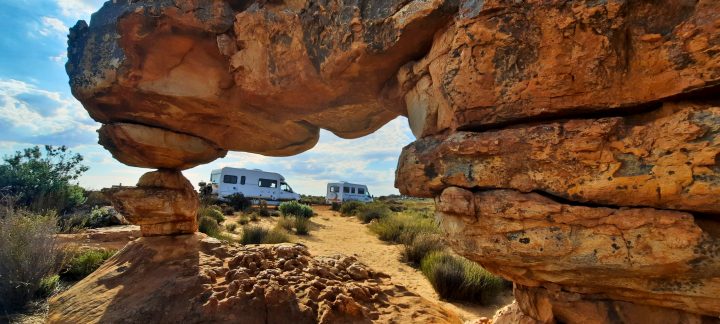
In these strange times when you must wear a mask, sanitise your hands in public places and worry if that person’s killer cough reached you, the idea of a self-contained adventure inside a travelling cottage with fridge, stove, shower and double bed was compelling. For exploring the Cederberg in the Western Cape in a time of coronavirus, a campervan seemed perfect for the job.
All photographs by Don Pinnock
North of Ceres and a little beyond Op Die Berg, the tar gives way to gravel and the purple mountains of the Cederberg rise higher and higher around you, all leaning to the left as though some ancient cosmic wind once howled across this gnarly land. Time has been hard at work here.
From the crest of the high Blinkberg Pass – the gateway to the southern Cederberg – you can see the road winding down into a deep valley. If you look closely you’ll notice, far below, a small building beside an established oak tree. Arriving there, it’s clear the cottage is from another age. On its wall above some tables and white umbrellas, in wonky writing, is a sign: Aankoms (arrival).
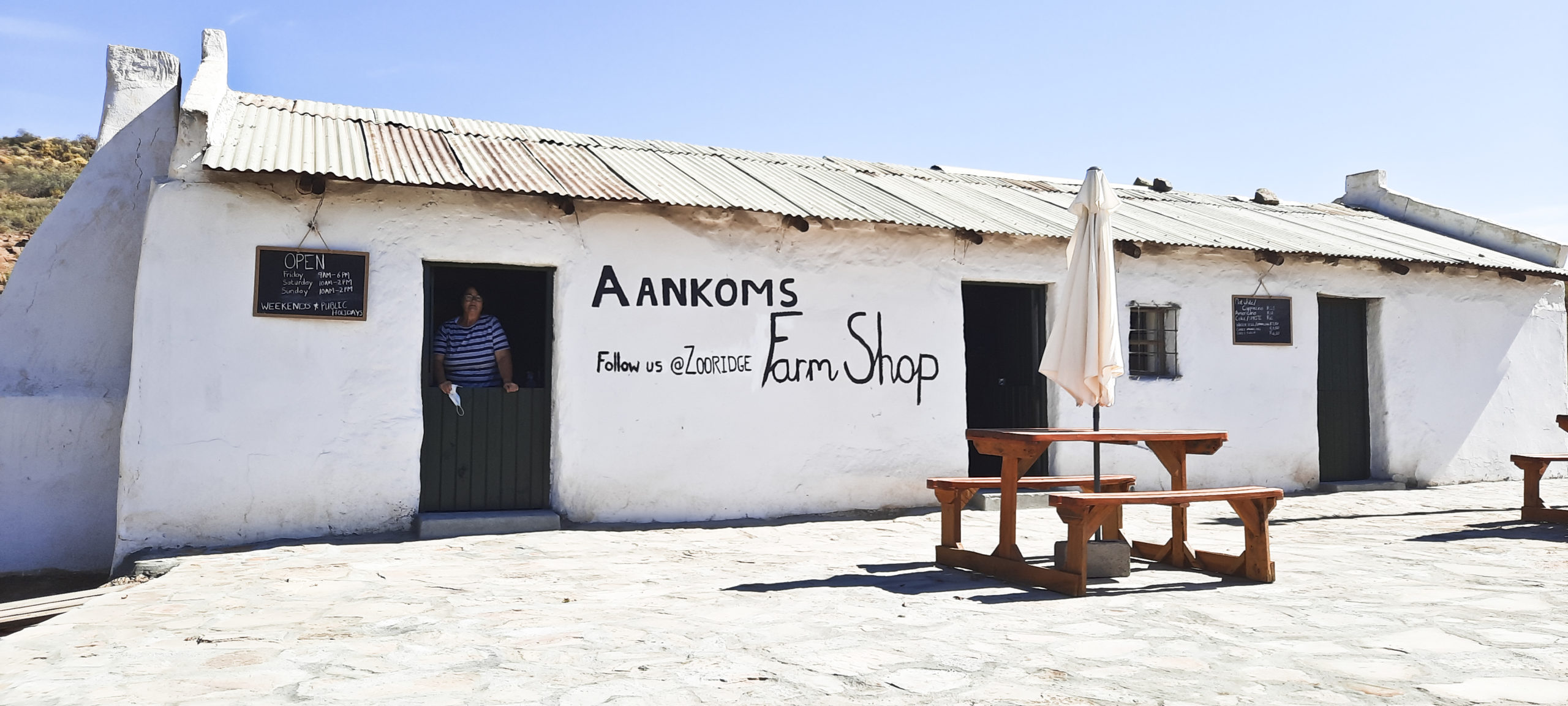
Aankoms Farm Shop at the southern entrance to the Cederberg
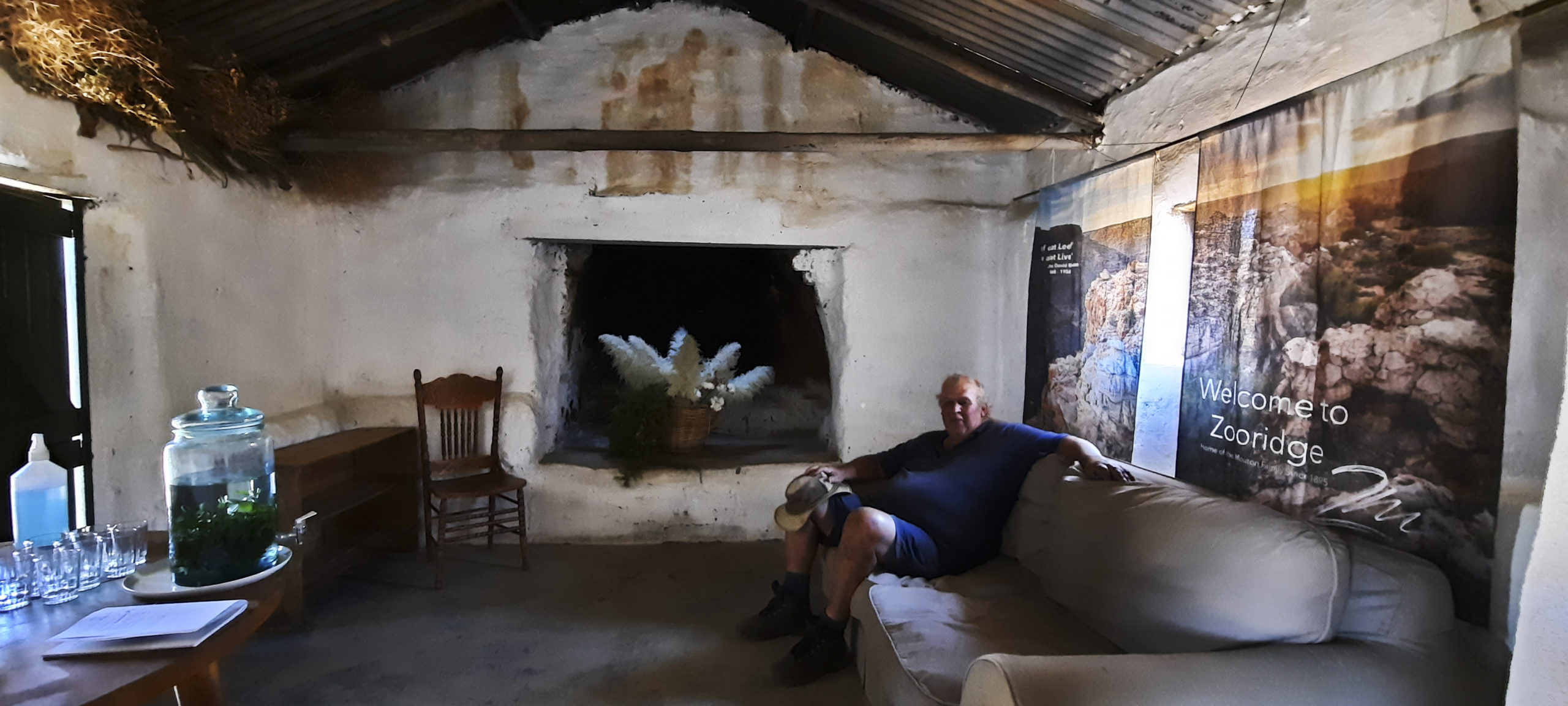
Koos Mouton in the Aankoms Farm Shop
This is the coffee shop of the Mouton family, local farmers whose forebears have been in the valley for five generations. Adriette welcomed us with strong espresso, koekies and warm banter. All around was local produce, excellent honey and to-die-for peanut butter and oat bolletjies.
As we were sitting on a comfortable couch in what must once have been the cottage kitchen, Adriette’s husband, Koos, arrived, blocking the light as he stooped through the door. Koos is a quiet, smiling giant of a man who says he could never find shoes to fit until someone recently posted him a pair of size 12s.
Hospitable people like Koos and Adriette, wild valleys, golden sandstone outcrops and weirdly leaning mountains are what the Cederberg is all about, a magical, almost secret haven for Capetonians who know about it but where most people in the Western Cape’s cities have never been.
Early settlers to the area came here on horseback, mainly from Clanwilliam in the west or through the Bokkeveld in the south. They found it to be good and fetched their belongings on ox-drawn sleighs. The first road, Ou Kaapse Weg, came down the Breekkrans Valley using game paths that required huge boulders to be levered out the way.
Two days earlier we’d ventured up the extraordinary Katbakkies Pass (it seemed like a rocket launching slope in parts) to Kagga Kamma further east. It’s always surprising to find so much luxury in such isolation, with restaurants, beautiful chalets, a pool in a jaw-dropping location and even a massage cabin perched atop a rock ridge that would make a good stage set for a film about Mars.
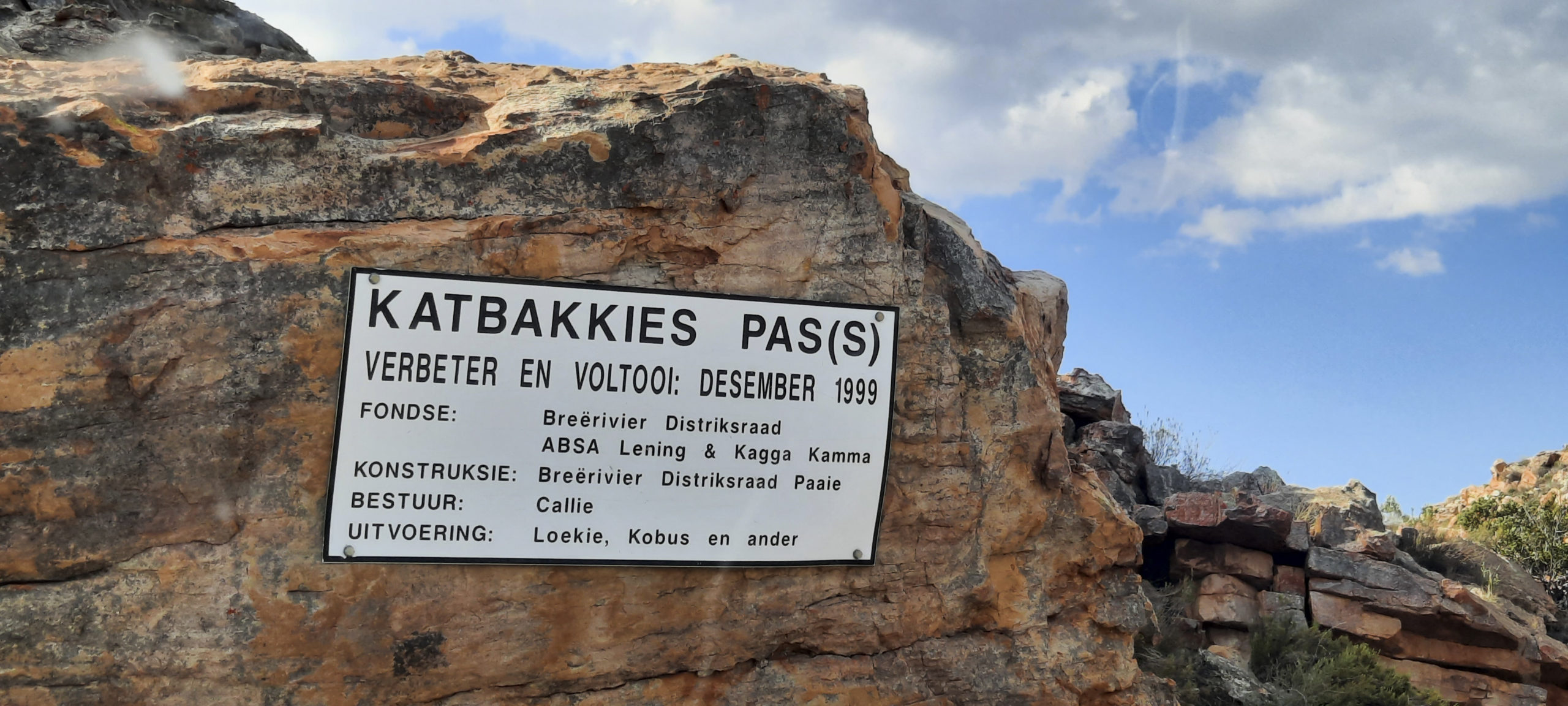
Katbakkies Pass is wild and wonderful
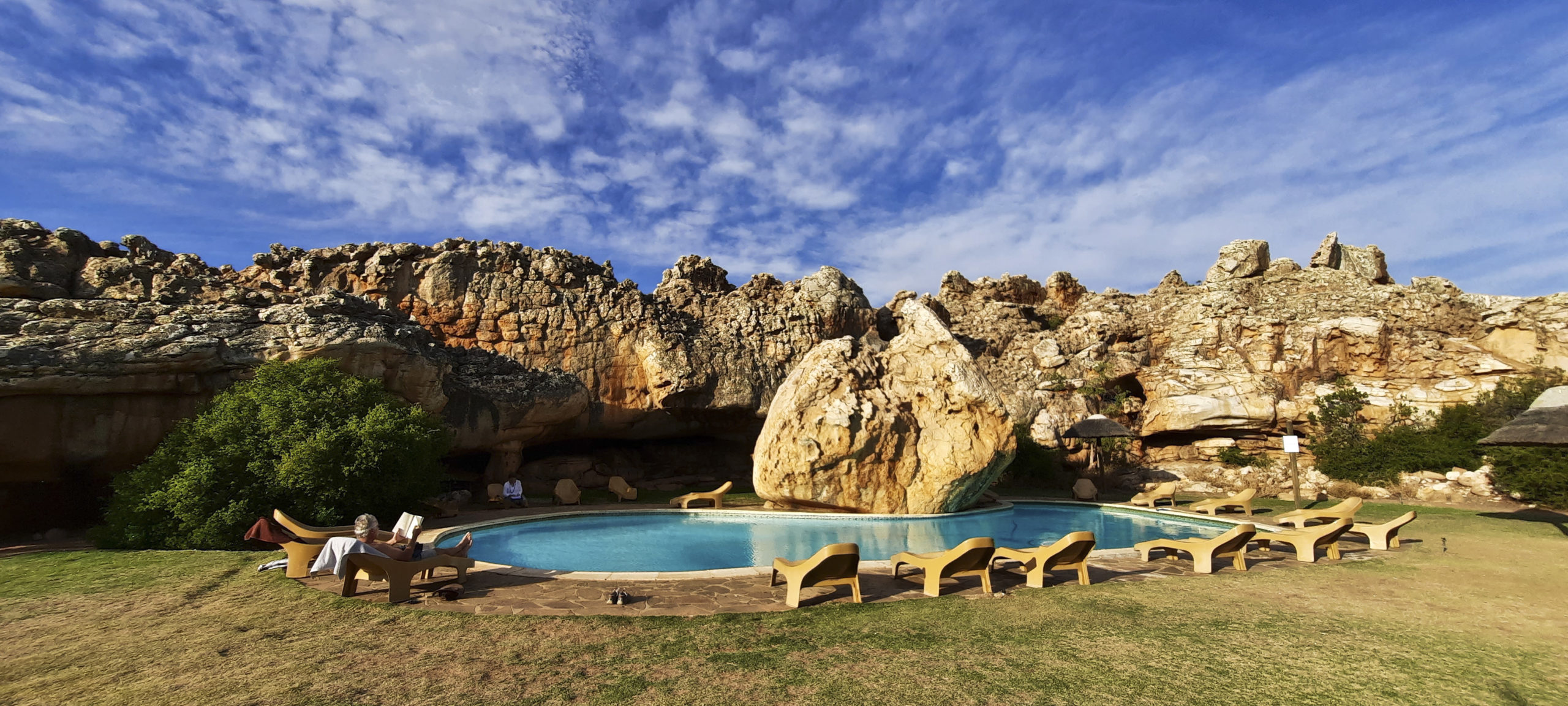
The glorious pool at Kagga Kamma
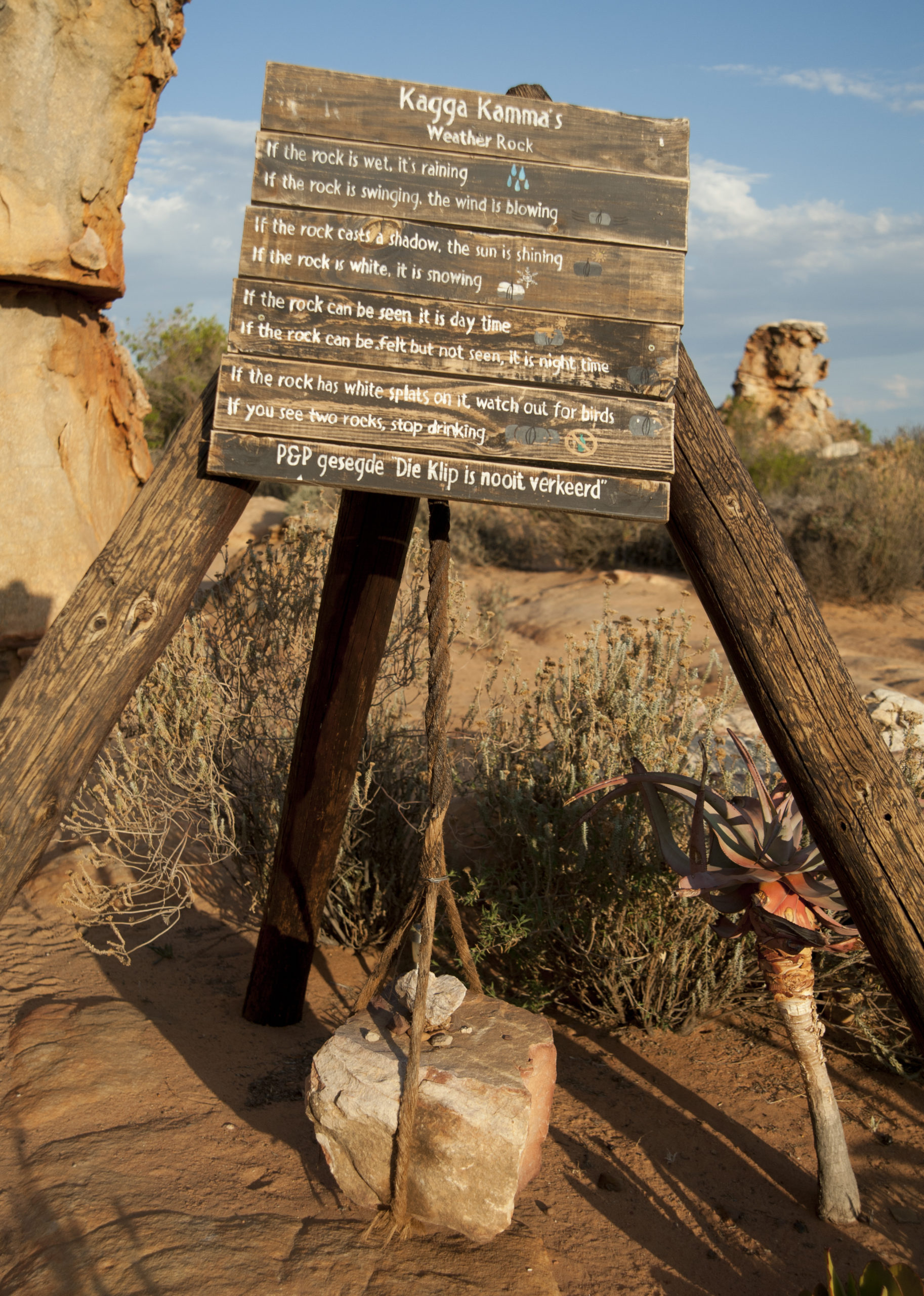
Weather check at Kagga Kamma

Our first night in the Cederberg at Kagga Kamma we celebrated with good wine
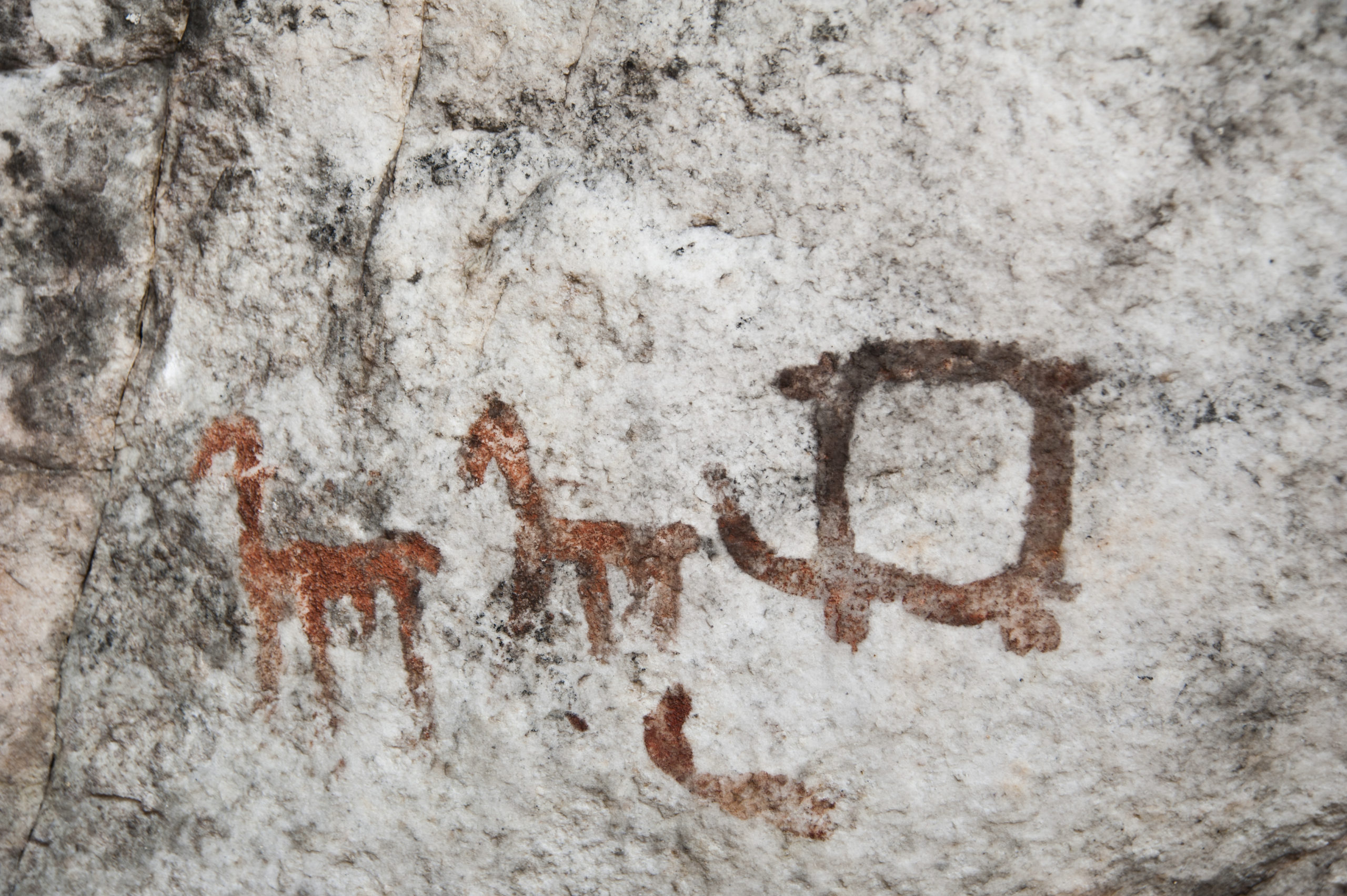
Finding a Xam depiction of an ox-wagon at Kagga Kamma seemed entirely appropriate
An extremely knowledgeable Shaun von Altene took us to visit some of the /Xam rock art that is everywhere in the Cederberg, rendered by a now exterminated culture. It was sad, poignant and exquisitely painted. We also peered into the Milky Way through the telescope and wisdom of Garriek Myburgh. The sky was black and sparkling with the billions of stars and our two neighbouring galaxies which you never get to see in a city.
The five campsites are suitable for ‘wild’ camping, having no water or power, though the ablutions are good and the pool is but a few steps away. Being in a campervan, of course, that was no problem.
Just then summer was refusing to concede to autumn and the air temperature was in the upper 30s, so the pool was a good thing. The water, though, must have been sucked up from a deep ice cave so fortitude was required.
Not far up the road from the Mouton’s winkeltjie we pulled into Mount Ceder. Each of its campsites has its own ablution and kitchen with solar and hot water, the site is grassed under shady trees and the river’s just down the slope. Someone clearly gave a lot of thought to making campers happy.
Nearby is a lodge with a restaurant and a small shop – it’s the place to stock up on Mount Ceder’s legendary olive oil and cured kalamata olives. As the sun sank, we tied on some pretty lures and did our bit helping to clear the river of alien bass. You eat them in the knowledge that you’re doing good for the environment. Hook and cook.
The next day, at the crest of yet another high pass – Grootrivier Hoogte – with sweeping views down either side, we were captured by a hard-drinking group of escapees from their wives on a boys’ binge weekend. “Kom, drink, eet,” they insisted, stepping into the road and forcing us to park. Boeremusiek was pumping from the back of one of four bakkies and on the fire were rolls of boerewors and lamb’s liver skilpadjies.
Before we could protest, the caps were whipped off ice cold beers and handed to us. There was no escape. They were friends and friends of friends from dorpies all over the West Coast and heading for Cederberg Backpackers Oasis to camp and, presumably, eat more braai and drink more beer and other strong liquids.
It took us about half an hour to extract ourselves from their conviviality and, as we negotiated down the pass’s steep hairpins, we did worry how they were going to make it to the bottom alive. The afterglow of their raucous generosity stayed with us all the way to Nuwerust.

Sunset on the road
The farm’s lawned campsite with water, power and shady trees was a balm after the dust and corrugations to get there. We were welcomed by Steven Windell and his dog Max, and the next morning taken under the wing of Louise Eesterhuysen.
She, too, is another descendent of a long line of Cederbergers and a veritable history book of the area. Nuwerust is a living museum with stone sheds filled with dusty, spiderwebbed implements from another age.
There’s a kapkar (pony trap), the remains of a waterwheel for grinding mielies, giant hand pump bellows for a forge, tools you’d never see in a hardware store today, tea, coffee and sweet tins from mid last century and a massive family Bible with brass catches and cornices printed in Dordrecht, Holland, in 1756.
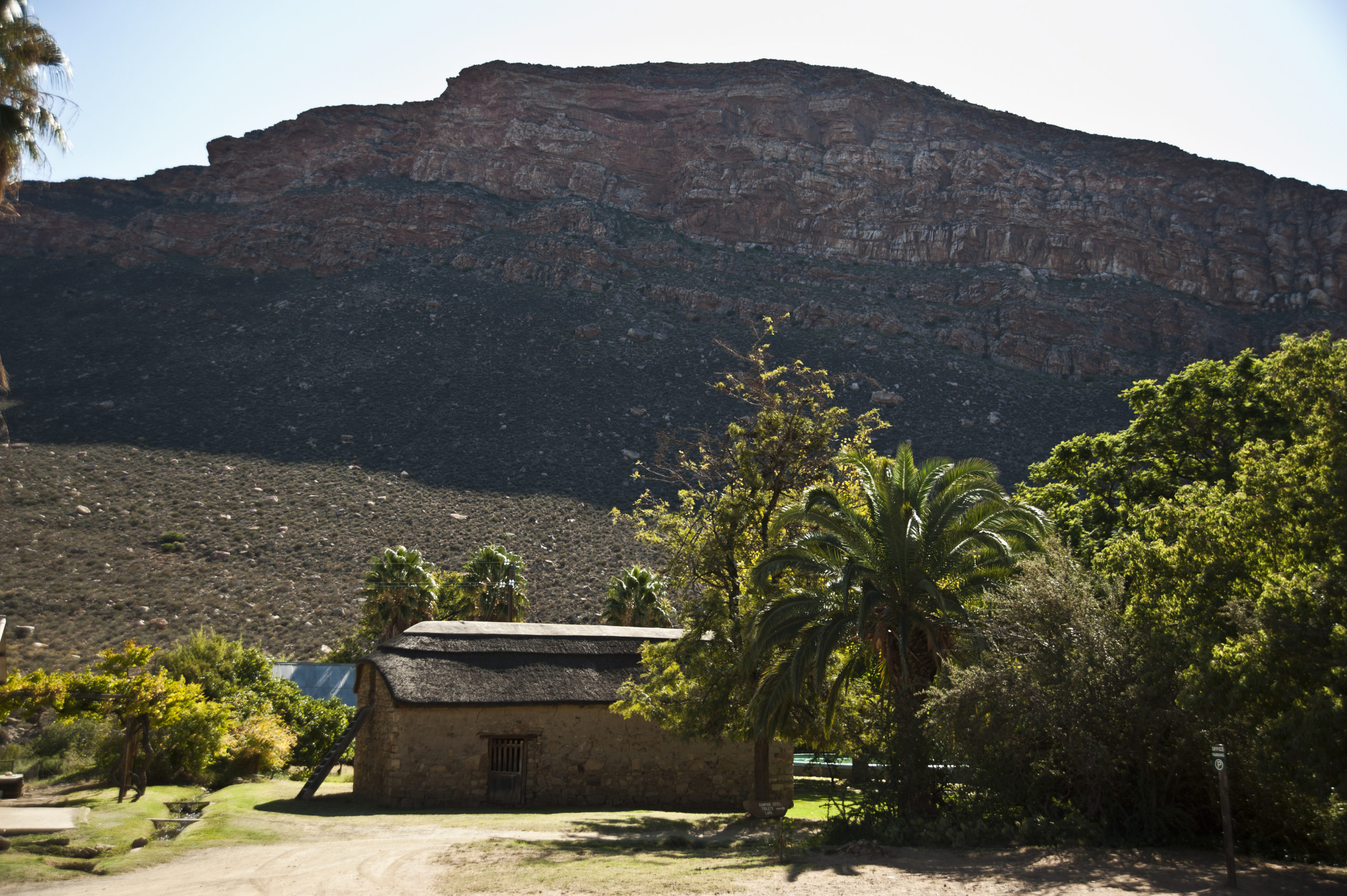
The old barn at Nuwerust
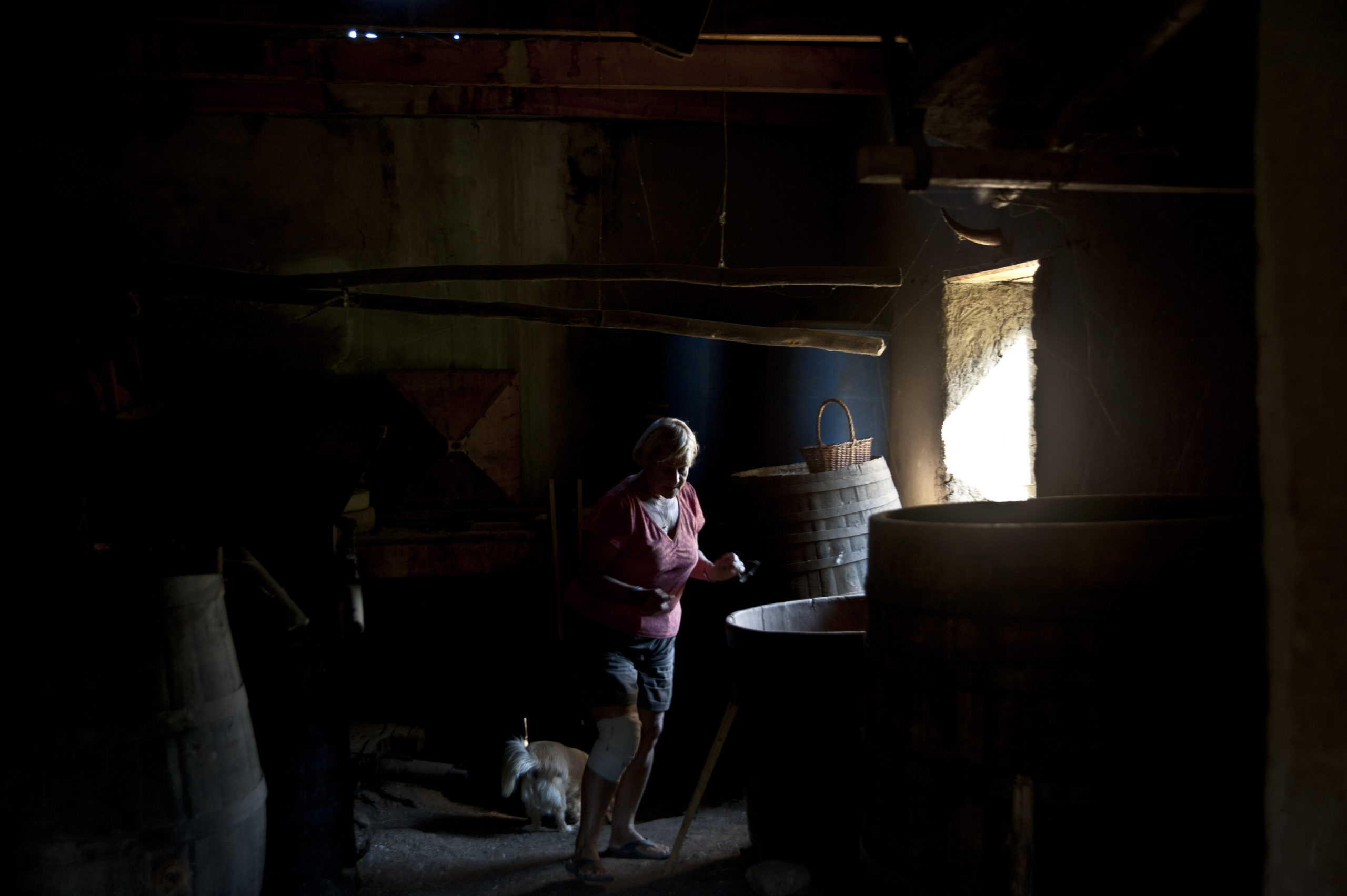
The old watermill and forge at Nuwerust
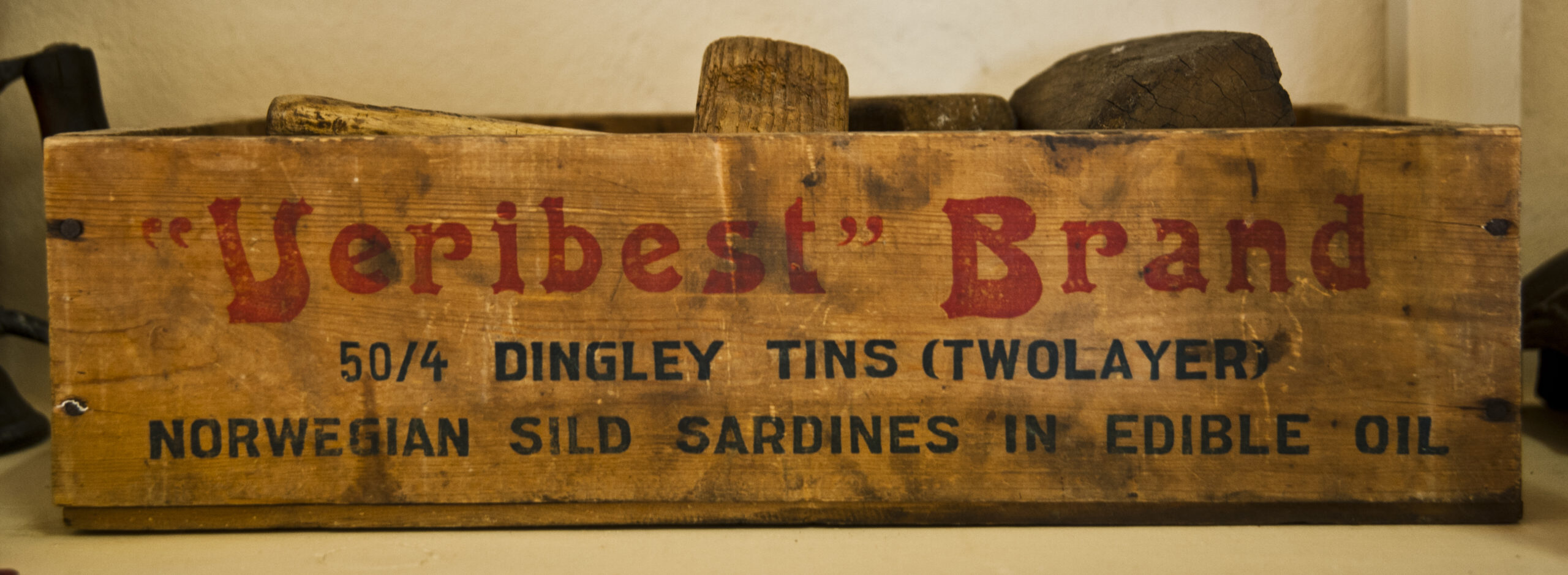
Memorabilia in the informal museum at Nuwerust
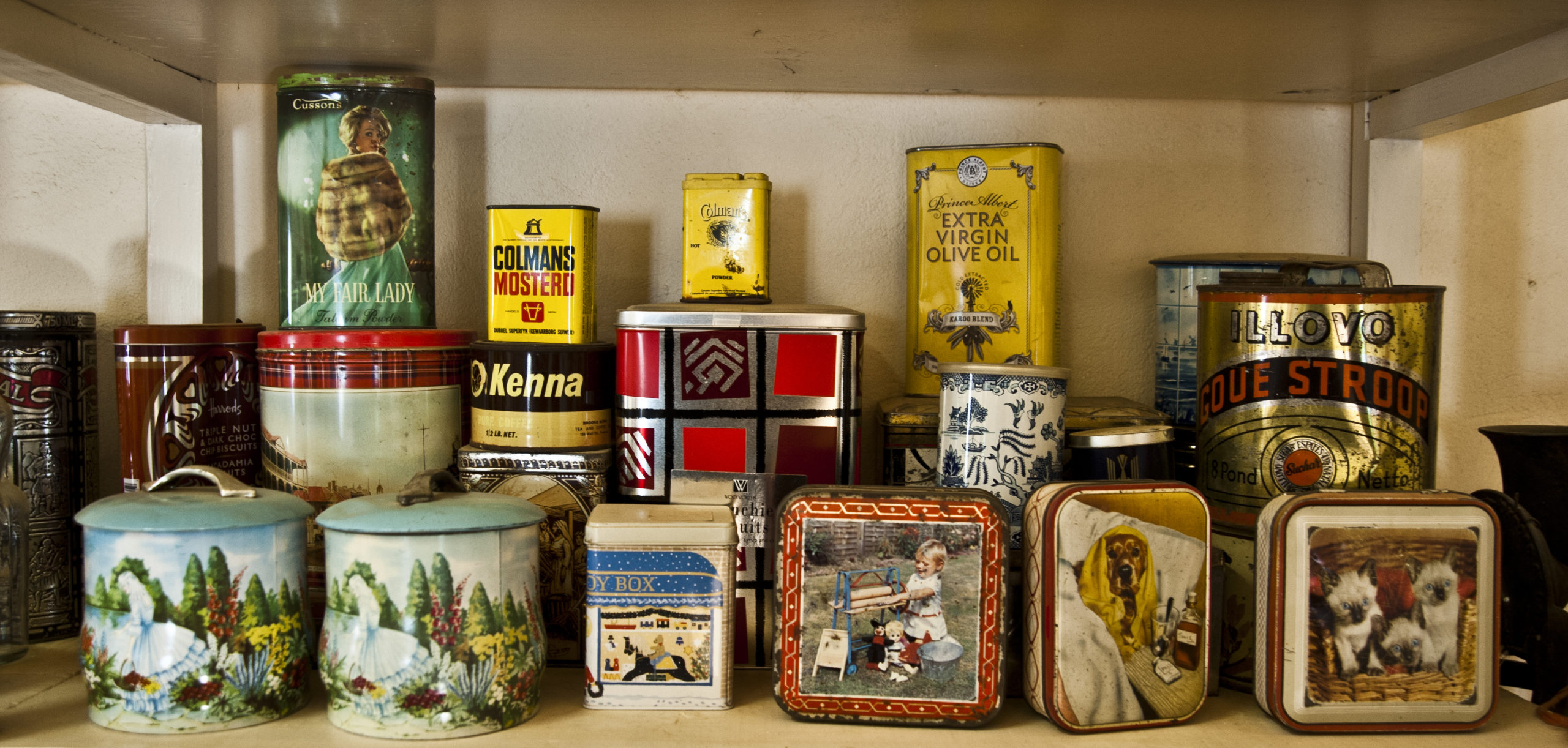
Memorabilia in the informal museum ay Nuwerust
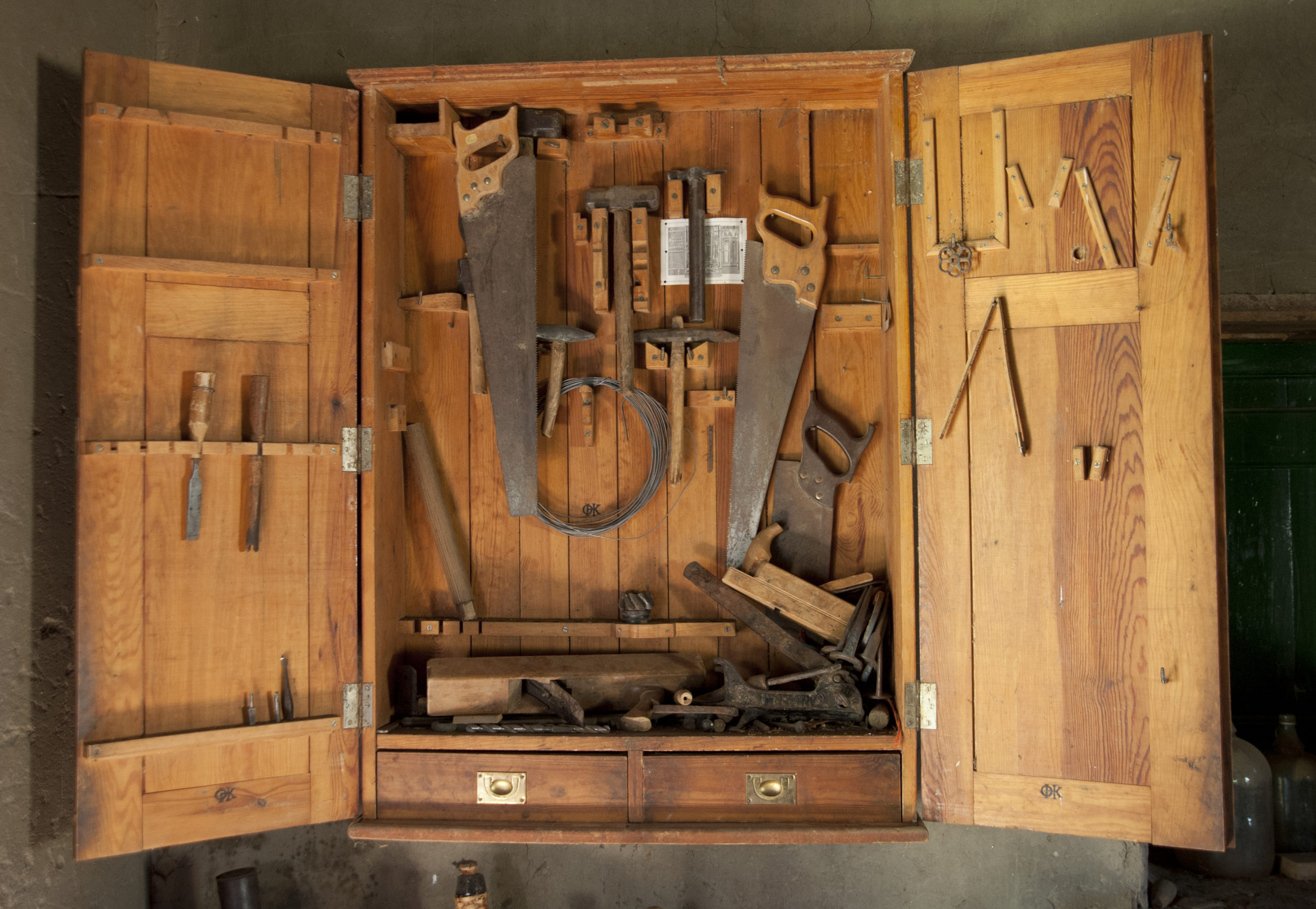
A hand-crafted farmer’s tool cupboard at Nuwerust
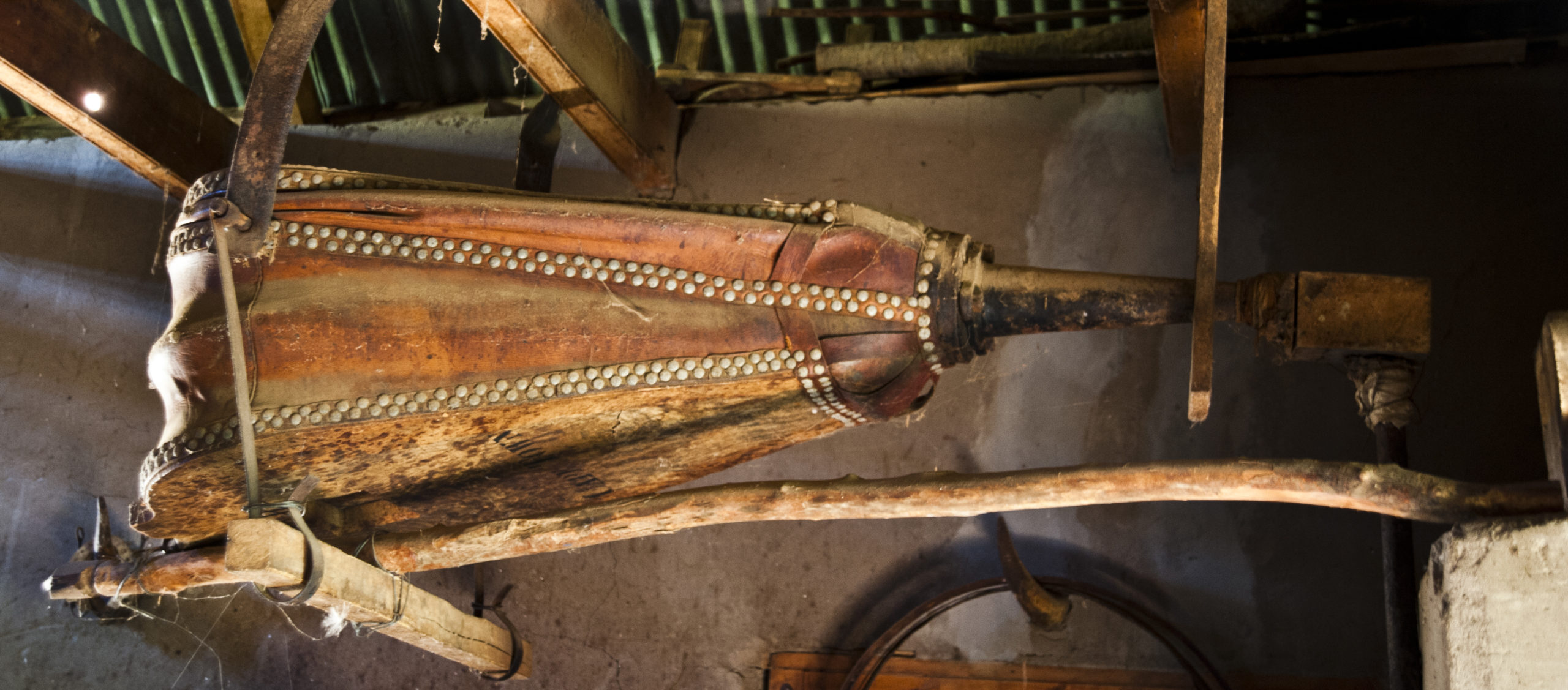
Forge bellows at Nuwerust
“I really must get all this cleaned up,” Louise said. “I’m the only one left who knows what all this stuff is for. My children aren’t into farming. One of my sons is an actuary in Georgia. And this Bible – children used to flip through it looking at the pictures but it’s valuable, so I don’t let them do that anymore.”
Just up the road is Oasis where you can hire a campsite, tent or bed-sized wooden A-frame for R250 a night, bedding included. It’s something of an institution and a magnet for overlanders, bikers and hikers, with a restaurant and pub attached. It’s been run by the Kasten family for decades.
“I keep my prices low because locals are my lifeblood”, said the charismatic Gerrit Kasten. “Fancy places are going up around here with prices that make it difficult for someone on a budget. I give good value.”
Oasis is a favourite for rock climbers, but also for weekenders on a jol. The restaurant serves basic, honest fare like bacon and egg breakfasts, toasted sandwiches, spareribs with chips and chicken schnitzel.
The rowdy crowd who’d captured us on the pass had made their way there the night before. “Those guys had so much booze,” said Gerrit, “quite a few never even got to their tents and slept where they fell.” It’s a good job the site is lawned and not sand.
Not far along the road into the High Cederberg is Kromrivier, accessed down a nail-biting hairpin pass amid layer after layer of purple mountains. Like many places in the area, it’s an old Trekboer farm that’s been in the Nieuwhout family for many generations but has branched out into accommodation. There are magnificent chalets – comparable with the best in the world – and campsites along the river which must rank among the finest in the Cederberg, each with its own kitchen, toilet and hot shower on a lawn under large oaks. In every direction are jagged, golden rock outcrops.
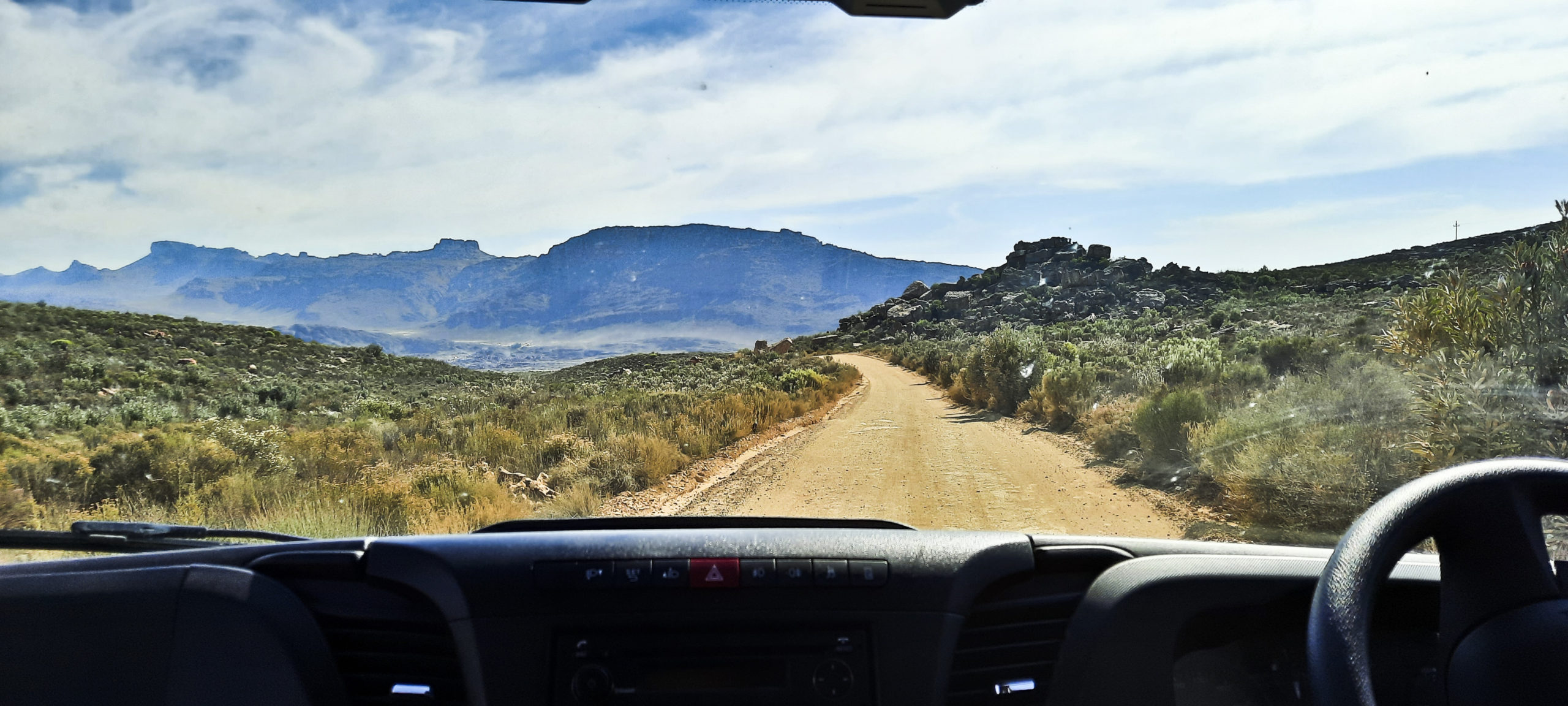
Contemplating the high mountains we will soon have to go over
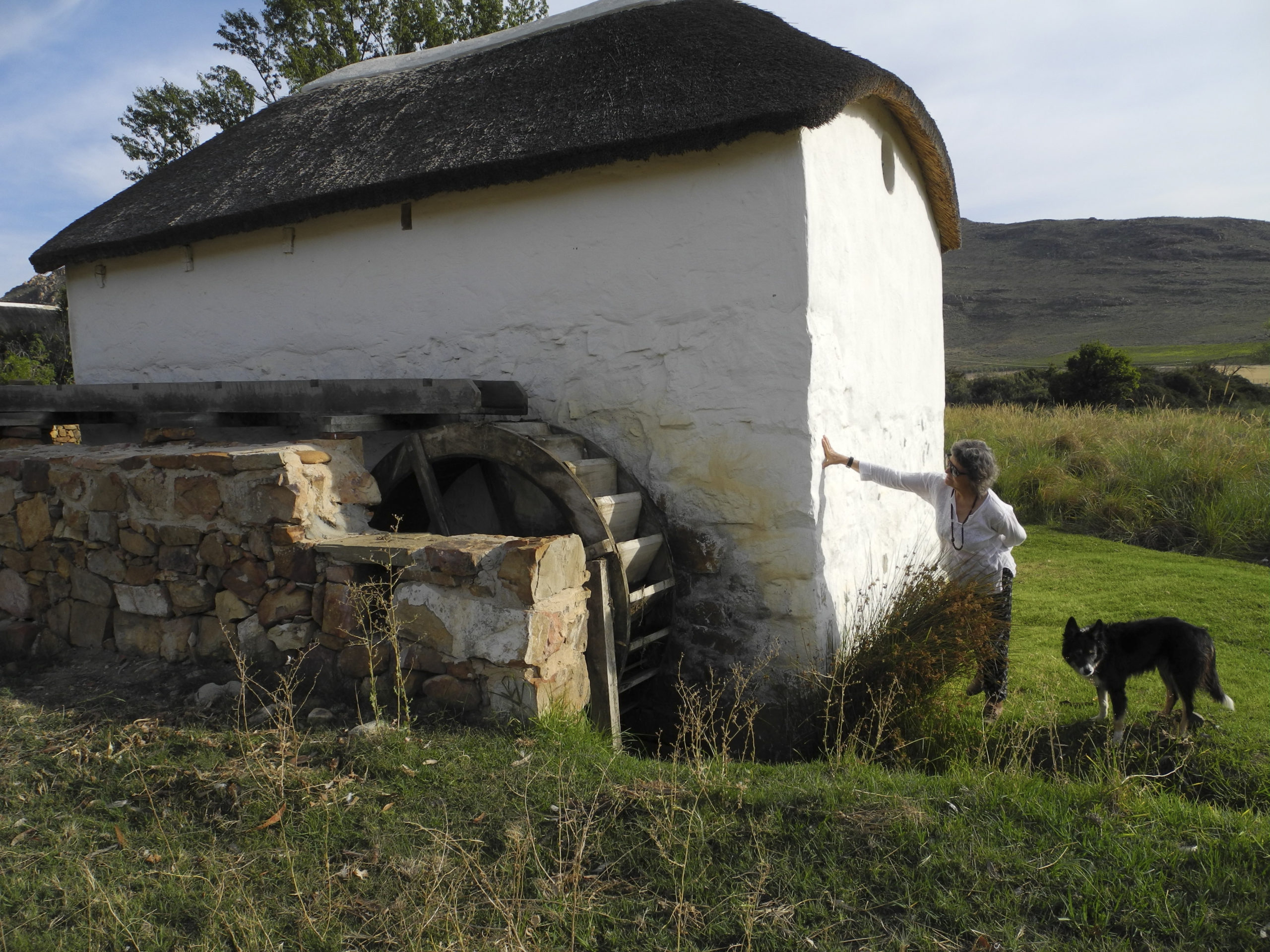
The old watermill at Kromrivier is beautifully restored
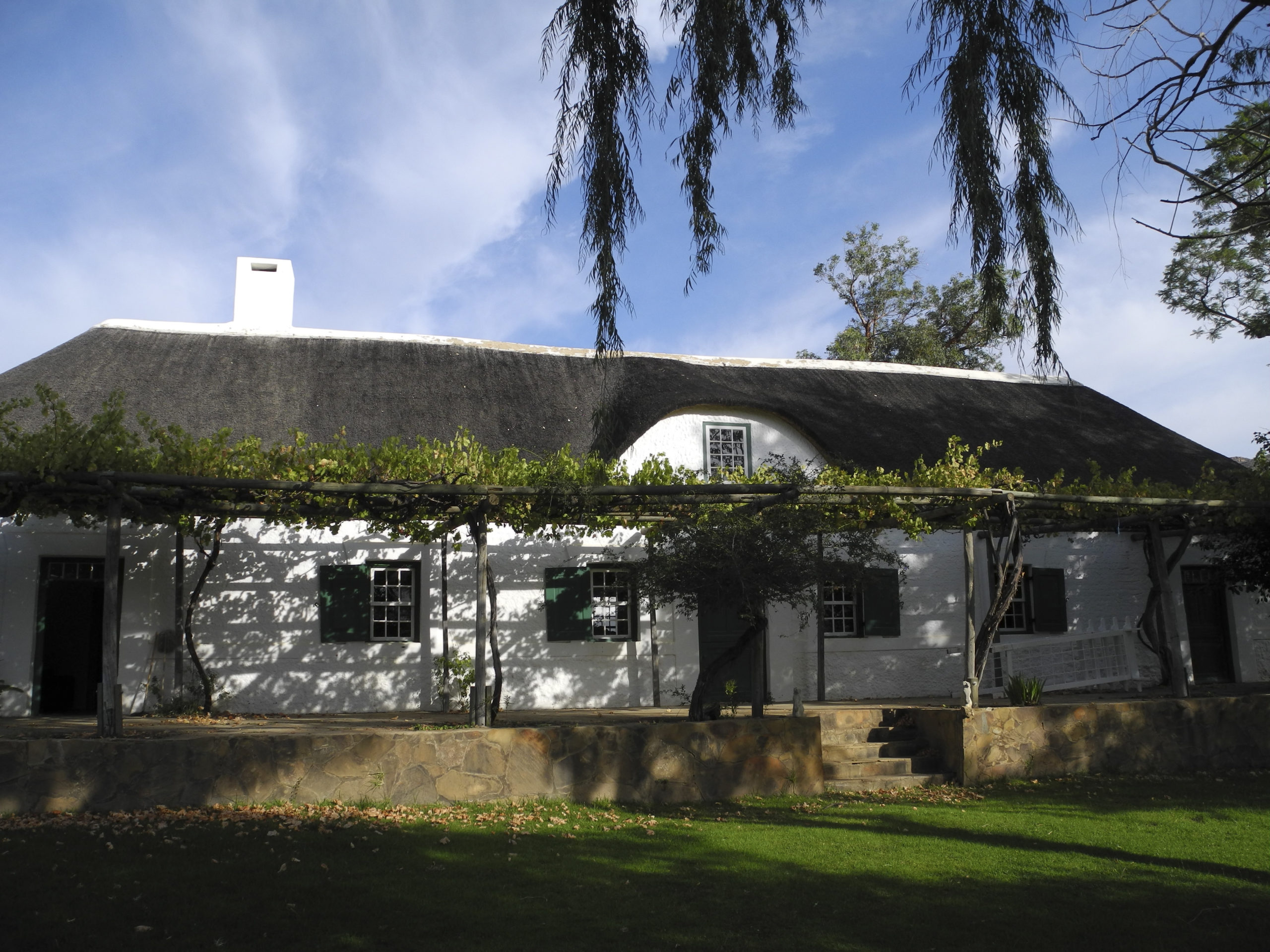
The Kromrivier homestead
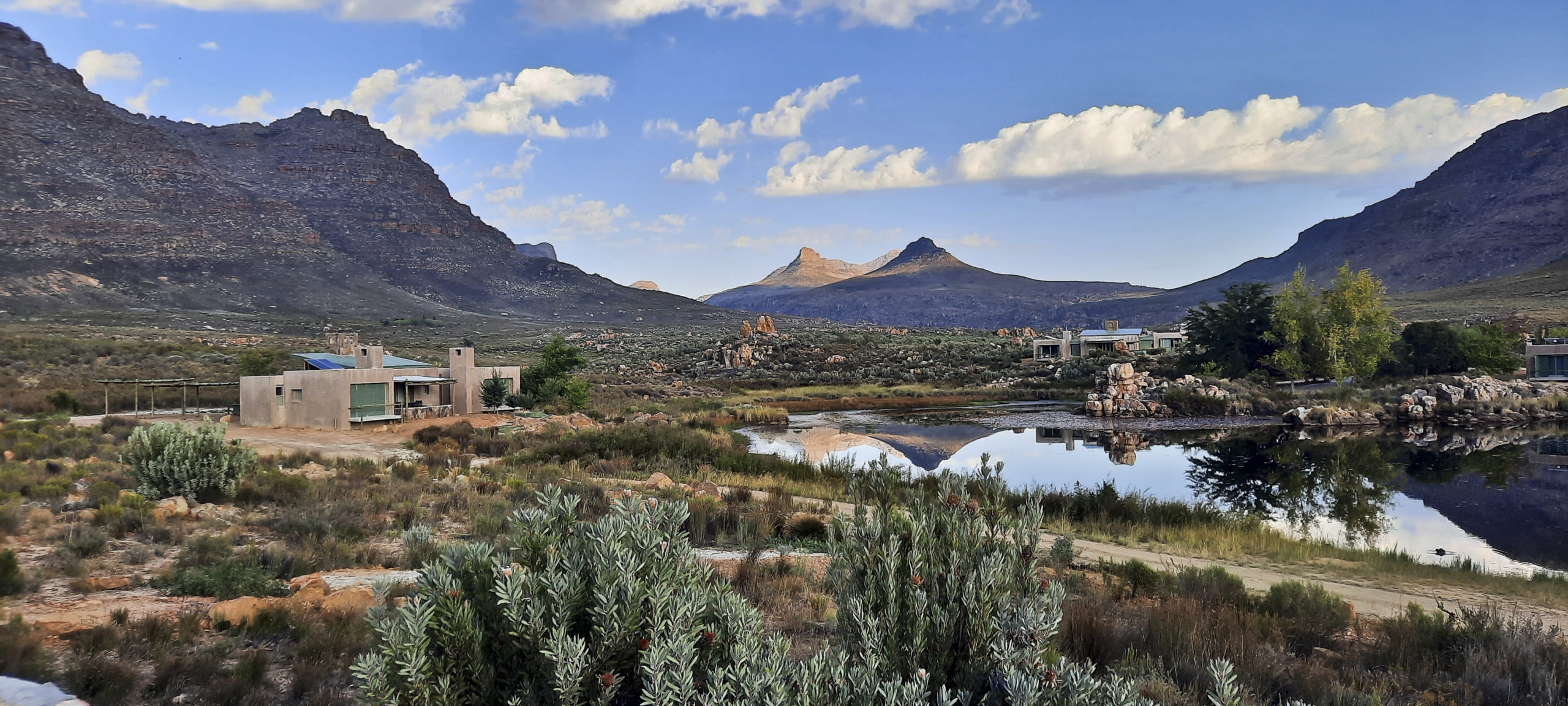
The spectacular chalets at Kromrivier
The farm was staked out in the mid-19th century in traditional style. Its first owner, Daniel Theron, saddled his horse at an oak tree near a spring and rode as fast and hard as he could to the foot of Sugarloaf Peak, then turned east beyond the distinctive Maltese Cross, then back to the oak tree. All that was within the compass of his ride in a single day was registered as Kromrivier Farm. It was eventually bought by the Nieuwhout family, who still own it.
There’s an intact old waterwheel mill and a plaashuis with rooms boasting hand-painted mouldings around its cedarwood windows and doors.
From Kromrivier we dropped down off the Cederberg to refuel at Clanwilliam, then scooted up the Pakhuis Pass to Die Poort, a hideaway among red cliffs lovingly assembled by former international banker Manus Visser. We pulled the vans into a clearing between a beetling rock face and some large bluegums that buzzed with bees.
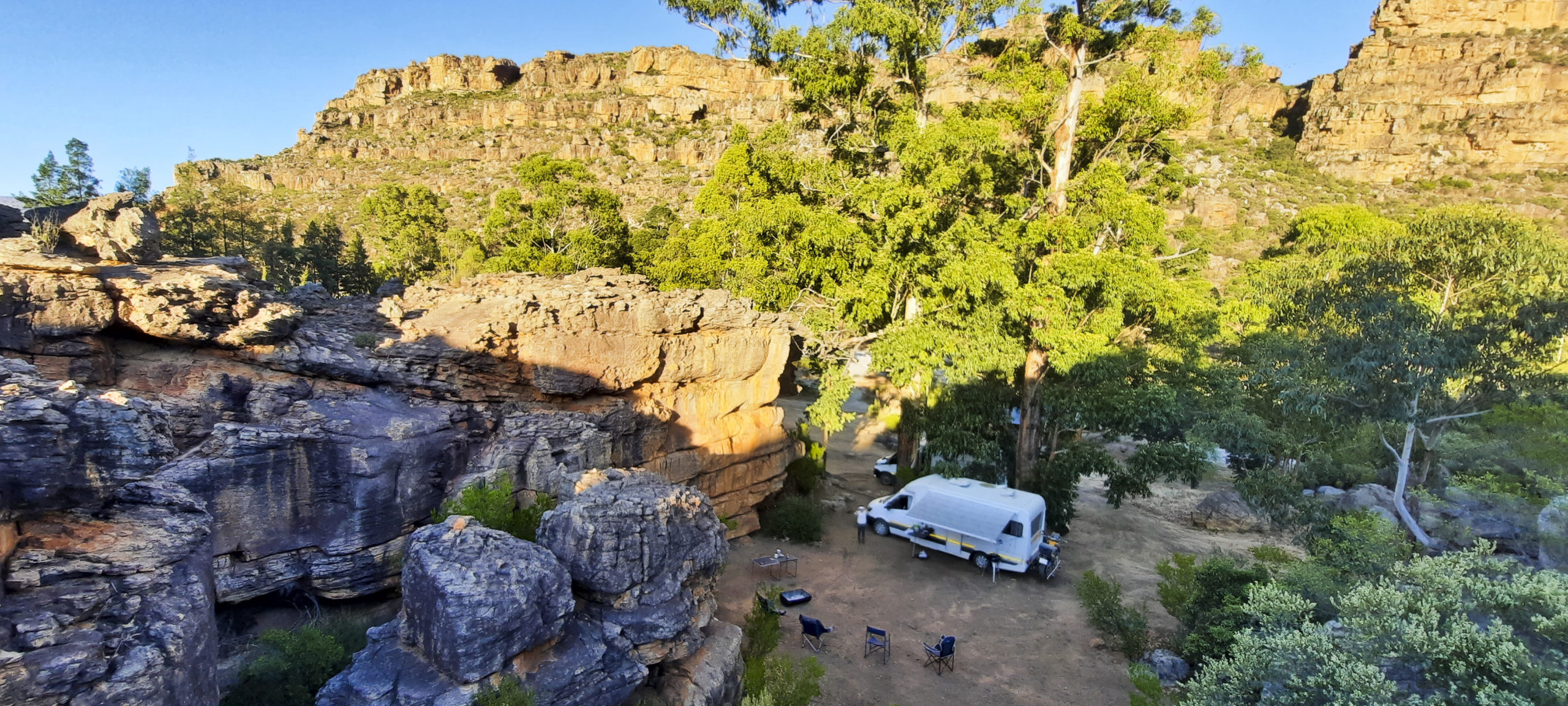
In blissful isolation at Die Poort
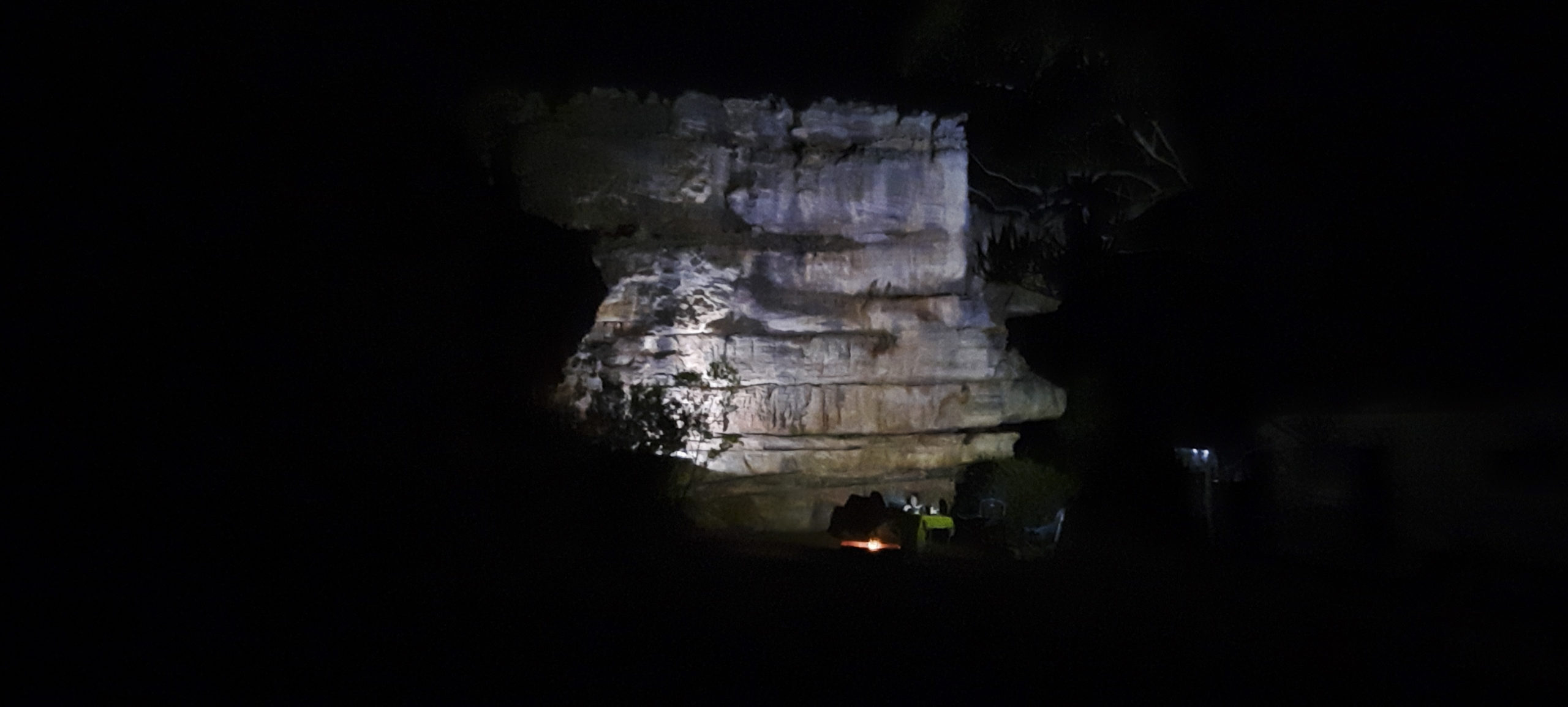
Campfire at Die Poort under cliffs and stars
When Manus had had enough of rushing around the world, he retired and bought the farm and its mountain. Later he sold the farm but kept the mountain. The place exudes an air of secrecy, with a few cabins, several caravans parked permanently beside their own kitchens and some campsites.
“I didn’t really create Die Poort as a commercial exercise, but because I enjoy people,” he said as we sipped his aromatic, hand-crafted red wine. “I used to have trouble with the local baboons,” he added, gazing at the cliffs across the narrow valley. “But I now have an agreement with them and they leave me alone.” We didn’t press him on the nature of the contract.
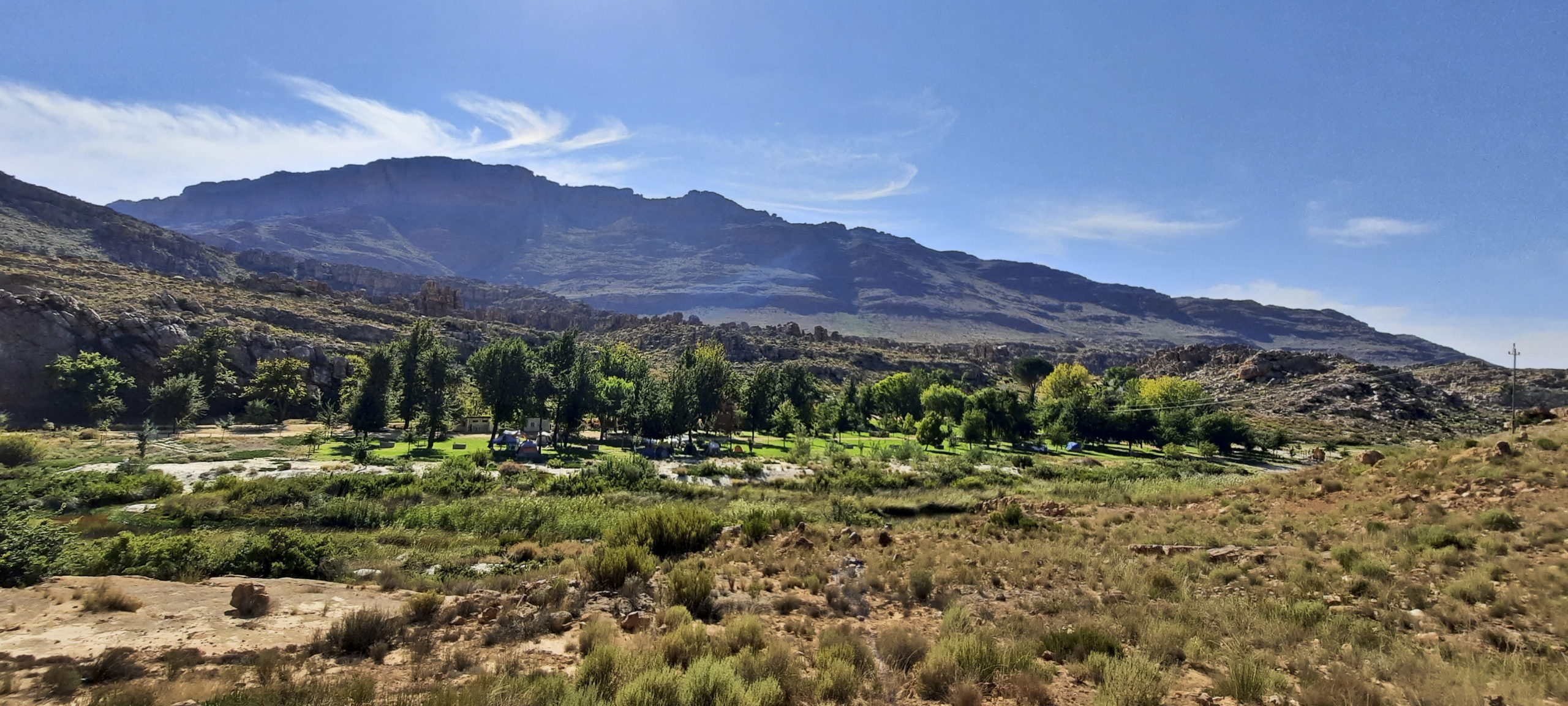
The Sanddrif campsite below the Wolfberg Cracks
His campsite, our last stop, was an extremely hard place to leave. A better arrangement would have been to spend a few months there, or a year, or forever. But Maui wanted their campervan back and I had to deliver this story to Maverick Life and there was no wifi.
So we picked our way out the valley, did a brief visit to the legendary Traveller’s Rest to say hi to owner Charité van Rijswijk and walk the Sevilla Trail to look at its nine well-preserved rock art sites, then headed back out of the Cederberg over Pakhuis Pass. I know it sounds like a cliché, but we all vowed that, sure as God made little red apples, we’d be back.
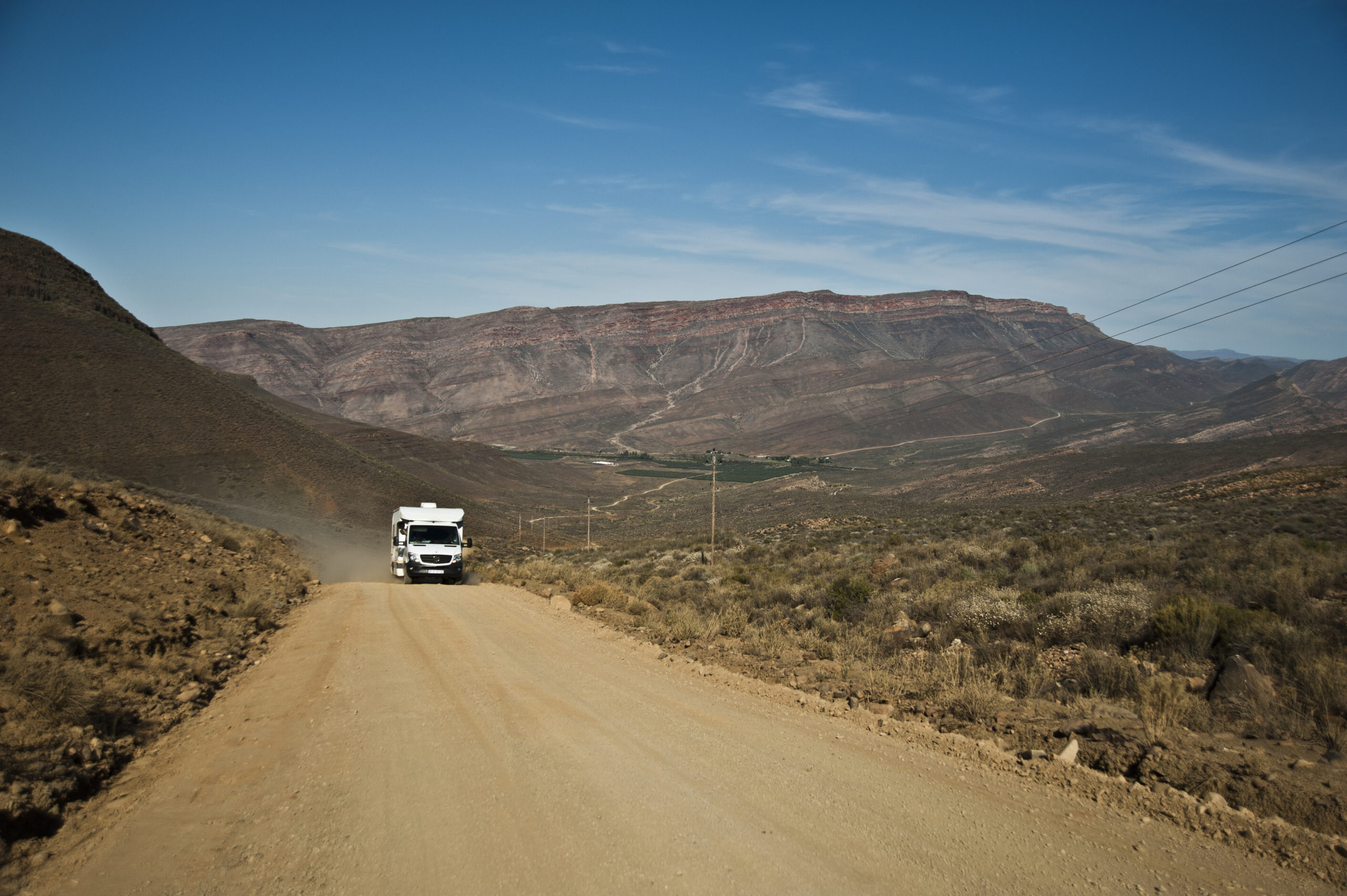
On the road to Cederberg Oasis
***
What you need to know
How to get there.
The route taken from Cape Town (there are other ways to get there) was N1 then R44 then R301 to Ceres. From there it’s the R303 through Op die Berg. From there, leave the R303 and head east until the tar runs out. At that point keep east to Kagga Kamma (it’s well signposted). To get to Mount Ceder, Nuwerust, Kromrivier and beyond return to where the tar ran out and turn northwards. That will take you to most of the places mentioned and ends in Clanwilliam from where you take the R364 over the Pakhuis Pass to Die Poort and Traveller’s Rest.
How to book
The Maui camper van was hired through Flame of Africa (email: [email protected] or phone: +27 (0) 31 762 2424).
Sites were individually booked through their websites. Kagga Kamma, Zooridge, Mount Ceder, Nuwerus, Kromrivier, Die Poort.
We didn’t get to stay at Sanddrif, but looked in and found the campsites to be excellent. It’s the best place from which to climb the Wolfberg Cracks, while Kromrivier is a good starting point for exploring Die Stadsaal caves and Truitjieskraal rock art sites. Permits to enter Cape Nature areas such as Stadsaal, Maltese Cross and Wolfberg Arch can be booked online or bought from Oasis, Kromrivier and most probably Sanddrif. There are other places to stay in the valleys which some Googling will reveal. DM/ ML
















 Become an Insider
Become an Insider
Comments - Please login in order to comment.